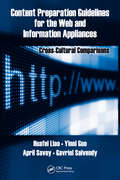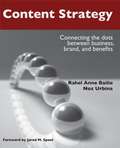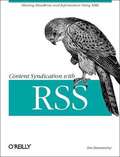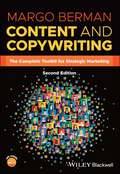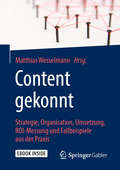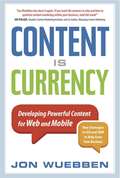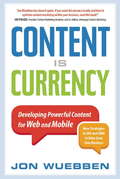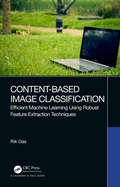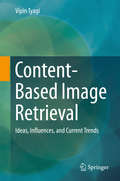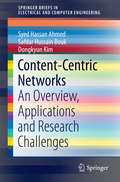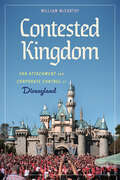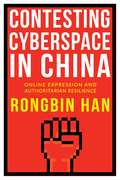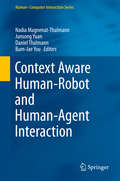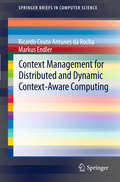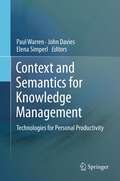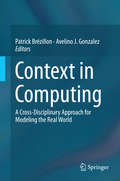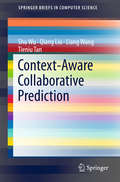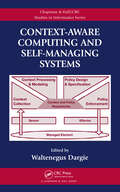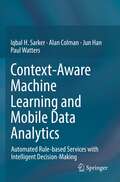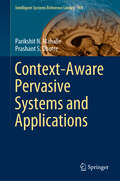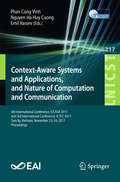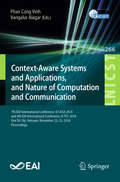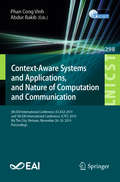- Table View
- List View
Content Preparation Guidelines for the Web and Information Appliances: Cross-Cultural Comparisons (Human Factors and Ergonomics)
by Gavriel Salvendy Huafei Liao Yinni Guo April SavoyContent preparation is an integral part of the usability equation: it answers the question of what information is needed for effective decision making. Once content preparation has been established, the question "how to present what" can be answered. Content Preparation Guidelines for the Web and Information Appliances: Cross-Cultural Comparisons p
Content Strategy
by Rahel Anne Bailie Noz UrbinaIf you've been asked to get funding for a content strategy initiative and need to build a compelling business case, if you've been approached by your staff to implement a content strategy and want to know the business benefits, or if you've been asked to sponsor a content strategy project and don't know what one is, this book is for you. Rahel Anne Bailie and Noz Urbina come from distinctly different backgrounds, but they share a deep understanding of how to help your organization build a content strategy. Content Strategy: Connecting the dots between business, brand, and benefits is the first content strategy book that focuses on project managers, department heads, and other decision makers who need to know about content strategy. It provides practical advice on how to sell, create, implement, and maintain a content strategy, including case studies that show both successful and not so successful efforts. Inside the Book Introduction to Content Strategy Why Content Strategy and Why Now The Value and ROI of Content Content Under the Hood Developing a Content Strategy Glossary, Bibliography, and Index
Content Strategy for Mobile
by Karen McgraneThis book discusses how to manage, publish and maintain your content across all emerging mobiles; by creating a holistic content strategy that can be used on a variety of devices.
Content Syndication with RSS
by Ben HammersleyOriginally developed by Netscape in 1999, RSS (which can stand for RDF Site Summary, Rich Site Summary, or Really Simple Syndication) is an XML-based format that allows web developers to describe and syndicate web site content. Content Syndication with RSSoffers webloggers, developers, and the programmers who support them a thorough explanation of syndication in general and RSS in particular. Written for web developers who want to offer XML-based feeds of their content, as well as developers who want to use
Content Syndication with RSS
by Ben HammersleyRSS is sprouting all over the Web, connecting weblogs and providing news feeds. Originally developed by Netscape in 1999, RSS (which can stand for RDF Site Summary, Rich Site Summary, or Really Simple Syndication) is an XML-based format that allows web developers to describe and syndicate web site content. Using RSS files allows developers to create a data feed that supplies headlines, links, and article summaries from a web site. Other sites can then incorporate them into their pages automatically. Although RSS is in widespread use, people struggle with its confusing and sometimes conflicting documentation and versions. Content Syndication with RSS is the first book to provide a comprehensive reference to the specifications and the tools that make syndication possible. Content Syndication with RSS offers webloggers, developers, and the programmers who support them a thorough explanation of syndication in general and RSS in particular. Written for web developers who want to offer XML-based feeds of their content, as well as developers who want to use the content that other people are syndicating, the book explores and explains metadata interpretation, different forms of content syndication, and the increasing use of web services in this field. This concise volume begins with an introduction to content syndication on the Internet: its purpose, limitations, and traditions, and answers the question of why would you consider "giving your content away" like this? Next, the book delves into the architecture of content syndication with an overview of the entire system, from content author to end user on another site. You'll follow the flow of data: content, referral data, publish-and-subscribe calls, with a detailed look at the protocols and standards possible at each step. Topics covered in the book include: Creating XML syndication feeds with RSS 0.9x and 2.0 Beyond headlines: creating richer feeds with RSS 1.0 and RDF metadata Using feeds to enrich a site or find information Publish and subscribe: intelligent updating News aggregators, such as Meerkat, Syndic8, and Newsisfree, and their web services Alternative industry-centric standards If you're interested in producing your own RSS feed, this step-by-step guide to implementation is the book you'll want in hand.
Content and Copywriting: The Complete Toolkit for Strategic Marketing
by Margo BermanLearn to create powerful, strategic copy for multiple channels, platforms, and storytelling templates Today, just writing strong content or catchy copy isn’t enough. You must also know how to create gripping messages and interactive engagement. Content and Copywriting: The Complete Toolkit for Strategic Marketing is your one-stop resource to sharpen your skills and explore innovative methods to reach your audience. This comprehensive real-world guide helps you create content for any device and consumer touchpoint by seamlessly integrating social media writing and advertising copywriting. As an award-winning copywriter, producer/director, and professor, Margo Berman explains conceptual strategies and writing techniques to develop dynamic copy for a wide range of traditional and emerging media. This step-by-step approach offers specific instructions for writing websites, blogs, social media, direct mail, product packaging, viral marketing, radio, television, and videos. This work also analyzes immersive, experiential, augmented, mixed, and virtual reality content, then presents tips to maximize results. This updated and expanded second edition contains dozens of new TV and radio storyboards and scripts, charts and infographics, templates and writing tips, exercises and examples, terminology lists, plus over 100 new images of innovative marketing campaigns. It also covers shareable content, digital storytelling, headline and slogan techniques, and interactive experiences. In addition, there is a valuable section with skill-building resources, references, and suggested readings. Featuring an extensive collection of innovative visual examples, content writing templates, and teaching and learning resources, Content and Copywriting: The Complete Toolkit for Strategic Marketing is the ideal textbook for undergraduate courses in advertising, communications, public relations, and integrated marketing, and an invaluable reference for graduate students and professionals alike.
Content gekonnt: Strategie, Organisation, Umsetzung, ROI-Messung und Fallbeispiele aus der Praxis
by Matthias WesselmannIn diesem Praxishandbuch berichten Content-Marketing-Experten über Erfahrungen, Lernkurven und Erfolgsfaktoren – leicht verständlich, anregend und mit aktuellen Fallbeispielen illustriert.Dass der Kunde König ist, galt zwar schon immer, wurde im Marketing in der Vergangenheit aber nur selten befolgt. Unternehmen nutzten die Kommunikationskanäle zur Selbstdarstellung und achteten oft nicht darauf, ob sich ihre Kunden überhaupt dafür interessierten. Dieses Modell funktioniert im Zeitalter des Informationsüberangebots nicht mehr. Nun ist Marketing mit umgekehrter Stoßrichtung notwendig – aus Push- wird Pull-Kommunikation. Um relevant und erfolgreich zu sein, müssen Inhalte von potentiellen Kunden gesucht, gefunden und wertgeschätzt werden sowie eine dem Unternehmensziel förderliche Aktion auslösen. Das stellt völlig neue Anforderungen an die Organisation der Marketing-Arbeit und die Orchestrierung der Kommunikation. Der Job wird inhaltlich und strukturell anspruchsvoller. Zugleich ist in der Unternehmensführung ein neues Verständnis dafür erforderlich, was Marketingkommunikation zum Unternehmenserfolg beiträgt und welche Konsequenzen daraus intern folgen.Mit Beiträgen von Dr. Sepita Ansari Pir Seraei, Szyzygy PerformanceDr. Marc Calmbach, SINUS-InstitutChristian Clawien, fischerAppeltDr. James Edwards, SINUS-InstitutDr. Sabine Fischer, idea economyPhD Tim Gohmann, Behavioral Science LabChristian Goy ,Behavioral Science LabAnne Griep, fischerAppeltOle Grönwoldt, Ole Grönwoldt Spatial DesignDr. Angela Harre, University of Applied Sciences EuropeMarkus Hartmann, Pricing für AgenturenSarah Helm, Coca-ColaDr. Rolf Illenberger, VRdirectIngo Kahnt Temel Kahyaoglu, The Group of Analysts Lena Kapp, eologyDr. Christian Kortmann, fischerAppeltLeif Lewinski, fischerAppeltCarmela Melone, The Group of AnalystsKatrin Menne, MerckJanine Michel, AccorHotels DeutschlandSibylle Milka-Böhm, AccorHotels DeutschlandJulia Niebergall, Universität MünsterHeiko Packwitz, Lufthansa Industry SolutionsDietrich Pflüger, fischerAppeltDirk U. Proff, blueforte Isabel Rehmer, fischerAppeltCarl-Jochen Reinhard, Fork Unstable MediaProf. Dr. Ulrike Röttger, Westfälische Wilhelms Universität MünsterHeiko Scherer, clapp mobile Arne-Kristian Schulz, blueforteMario Strack, eologyPaul Taggart, FORK Unstable MediaLeif Ullmann, nwtnPatricia Unfried, eology Dr. Pascal Volz, fischerAppeltAnne Wahl, AccorHotels DeutschlandMatthias Wesselmann, fischerAppelt
Content is Currency: Developing Powerful Content For Web And Mobile
by Jon WuebbenIn the digital age, content is no longer confined to the written page. It is spread across web and mobile, taking the form of podcasts, webinars, widgets, and blog posts. Powerful content tells the story of your product or business, but it means nothing if it's not written well, optimized for search and social media, and properly marketed. In Content is Currency content strategist Jon Wuebben explains the fine art of content development by utilizing the latest Search Engine Optimization (SEO) and Social Media Marketing (SMM) techniques, and provides you with the tools and strategies you need to get your online content noticed.
Content is Currency: Developing Powerful Content for Web and Mobile
by Jon WuebbenIn the digital age, content is no longer confined to the written page. It is spread across web and mobile, taking the form of podcasts, webinars, widgets, and blog posts. Powerful content tells the story of your product or business, but it means nothing if it's not written well, optimized for search and social media, and properly marketed. In Content is Currency content strategist Jon Wuebben explains the fine art of content development by utilizing the latest Search Engine Optimization (SEO) and Social Media Marketing (SMM) techniques, and provides you with the tools and strategies you need to get your online content noticed.
Content-Based Image Classification: Efficient Machine Learning Using Robust Feature Extraction Techniques
by Rik DasContent-Based Image Classification: Efficient Machine Learning Using Robust Feature Extraction Techniques is a comprehensive guide to research with invaluable image data. Social Science Research Network has revealed that 65% of people are visual learners. Research data provided by Hyerle (2000) has clearly shown 90% of information in the human brain is visual. Thus, it is no wonder that visual information processing in the brain is 60,000 times faster than text-based information (3M Corporation, 2001). Recently, we have witnessed a significant surge in conversing with images due to the popularity of social networking platforms. The other reason for embracing usage of image data is the mass availability of high-resolution cellphone cameras. Wide usage of image data in diversified application areas including medical science, media, sports, remote sensing, and so on, has spurred the need for further research in optimizing archival, maintenance, and retrieval of appropriate image content to leverage data-driven decision-making. This book demonstrates several techniques of image processing to represent image data in a desired format for information identification. It discusses the application of machine learning and deep learning for identifying and categorizing appropriate image data helpful in designing automated decision support systems. The book offers comprehensive coverage of the most essential topics, including: Image feature extraction with novel handcrafted techniques (traditional feature extraction) Image feature extraction with automated techniques (representation learning with CNNs) Significance of fusion-based approaches in enhancing classification accuracy MATLAB® codes for implementing the techniques Use of the Open Access data mining tool WEKA for multiple tasks The book is intended for budding researchers, technocrats, engineering students, and machine learning/deep learning enthusiasts who are willing to start their computer vision journey with content-based image recognition. The readers will get a clear picture of the essentials for transforming the image data into valuable means for insight generation. Readers will learn coding techniques necessary to propose novel mechanisms and disruptive approaches. The WEKA guide provided is beneficial for those uncomfortable coding for machine learning algorithms. The WEKA tool assists the learner in implementing machine learning algorithms with the click of a button. Thus, this book will be a stepping-stone for your machine learning journey. Please visit the author's website for any further guidance at https://www.rikdas.com/
Content-Based Image Retrieval: Ideas, Influences, and Current Trends
by Vipin TyagiThe book describes several techniques used to bridge the semantic gap and reflects on recent advancements in content-based image retrieval (CBIR). It presents insights into and the theoretical foundation of various essential concepts related to image searches, together with examples of natural and texture image types. The book discusses key challenges and research topics in the context of image retrieval, and provides descriptions of various image databases used in research studies. The area of image retrieval, and especially content-based image retrieval (CBIR), is a very exciting one, both for research and for commercial applications. The book explains the low-level features that can be extracted from an image (such as color, texture, shape) and several techniques used to successfully bridge the semantic gap in image retrieval, making it a valuable resource for students and researchers interested in the area of CBIR alike.
Content-Centric Networks: An Overview, Applications and Research Challenges (SpringerBriefs in Electrical and Computer Engineering #0)
by Syed Hassan Ahmed Safdar Hussain Bouk Dongkyun KimThis book introduces Content-Centric Networking (CCN), a networking paradigm that provides a simple and effective solution to the challenging demands of future wired and wireless communications. It provides an overview of the recent developments in the area of future internet technologies, bringing together the advancements that have been made in Information-Centric Networking (ICN) in general, with a focus on CCN. It begins with an introduction to the basics of CCN is followed by an overview of the current internet paradigm and its challenges. Next, an application perspective has been included, where the authors encompass the selected applications for CCN with recent refereed research and developments. These applications include Internet of Things (IoT), Smart Grid, Vehicular Ad hoc Networks (VANETs), and Wireless Sensor Networks (WSNs). The book is a useful reference source for practising researchers, and can be used as supporting material for undergraduate and graduate level courses in computer science and electrical engineering.
Contested Kingdom: Fan Attachment and Corporate Control at Disneyland
by William McCarthyIn Contested Kingdom: Fan Attachment and Corporate Control at Disneyland, William McCarthy presents a groundbreaking study centered on the history of Disneyland and Disney theme park enthusiasts. Focusing on two unexplored yet interconnected phenomena—the dynamic relationship between the Disney corporation and Southern Californian fans in both online and physical park settings over a span of more than three decades—this volume sheds new light on the meaning and purpose of Disneyland. Through a comprehensive analysis of the interwoven dimensions of individuals, place, and cognitive, affective, and behavioral processes, McCarthy explores the fervent sense of place attachment experienced by the approximately one million annual passholders who visit the park. McCarthy’s analysis extends beyond the physical world of Disneyland by delving into the evolution of Disney fandom, discourse, commerce, and social formations in online social platforms like Usenet, web discussion boards, and social media. By employing a mixed-methods approach incorporating interviews, participant observation, surveys, and data analysis, this study establishes a novel analytical framework for comprehending the interrelationships between the Disney corporation, its fan communities, and online social platforms. As the first in-depth longitudinal analysis of the ongoing struggle on successive social platforms between fan users and a corporate entity, Contested Kingdom provides valuable insights for scholars and future investigations.
Contesting Cyberspace in China: Online Expression and Authoritarian Resilience
by Rongbin HanThe Internet was supposed to be an antidote to authoritarianism. It can enable citizens to express themselves freely and organize outside state control. Yet while online activity has helped challenge authoritarian rule in some cases, other regimes have endured: no movement comparable to the Arab Spring has arisen in China. In Contesting Cyberspace in China, Rongbin Han offers a powerful counterintuitive explanation for the survival of the world’s largest authoritarian regime in the digital age.Han reveals the complex internal dynamics of online expression in China, showing how the state, service providers, and netizens negotiate the limits of discourse. He finds that state censorship has conditioned online expression, yet has failed to bring it under control. However, Han also finds that freer expression may work to the advantage of the regime because its critics are not the only ones empowered: the Internet has proved less threatening than expected due to the multiplicity of beliefs, identities, and values online. State-sponsored and spontaneous pro-government commenters have turned out to be a major presence on the Chinese internet, denigrating dissenters and barraging oppositional voices. Han explores the recruitment, training, and behavior of hired commenters, the “fifty-cent army,” as well as group identity formation among nationalistic Internet posters who see themselves as patriots defending China against online saboteurs. Drawing on a rich set of data collected through interviews, participant observation, and long-term online ethnography, as well as official reports and state directives, Contesting Cyberspace in China interrogates our assumptions about authoritarian resilience and the democratizing power of the Internet.
Context Aware Human-Robot and Human-Agent Interaction (Human–Computer Interaction Series)
by Daniel Thalmann Nadia Magnenat-Thalmann Junsong Yuan Bum-Jae YouThis is the first book to describe how Autonomous Virtual Humans and Social Robots can interact with real people, be aware of the environment around them, and react to various situations. Researchers from around the world present the main techniques for tracking and analysing humans and their behaviour and contemplate the potential for these virtual humans and robots to replace or stand in for their human counterparts, tackling areas such as awareness and reactions to real world stimuli and using the same modalities as humans do: verbal and body gestures, facial expressions and gaze to aid seamless human- computer interaction (HCI). The research presented in this volume is split into three sections: User Understanding through Multisensory Perception: deals with the analysis and recognition of a given situation or stimuli, addressing issues of facial recognition, body gestures and sound localization. Facial and Body Modelling Animation: presents the methods used in modelling and animating faces and bodies to generate realistic motion. Modelling Human Behaviours: presents the behavioural aspects of virtual humans and social robots when interacting and reacting to real humans and each other. Context Aware Human-Robot and Human-Agent Interaction would be of great use to students, academics and industry specialists in areas like Robotics, HCI, and Computer Graphics.
Context Management for Distributed and Dynamic Context-Aware Computing (SpringerBriefs in Computer Science)
by Markus Endler Ricardo Couto RochaResearch in context-aware computing has produced a number of middleware systems for context management. However, development of ubiquitous context-aware applications is still a challenge because most current middleware systems are still focused on isolated and static context-aware environments. Context-aware environments are inherently dynamic as a result of occasional additions or upgrade of sensors, applications or context inference mechanisms. Context Management for Distributed and Dynamic Context-Aware Computing proposes a novel architecture for context management based on the concept of context domains, allowing applications to keep context interests across distributed context management systems. The authors describe a distributed middleware that implements the aforementioned concepts, without compromising scalability and efficiency of context access.
Context and Semantics for Knowledge Management: Technologies for Personal Productivity
by John Davies Paul Warren Elena SimperlKnowledge and information are among the biggest assets of enterprises and organizations. However, efficiently managing, maintaining, accessing, and reusing this intangible treasure is difficult. Information overload makes it difficult to focus on the information that really matters; the fact that much corporate knowledge only resides in employees' heads seriously hampers reuse. The work described in this book is motivated by the need to increase the productivity of knowledge work. Based on results from the EU-funded ACTIVE project and complemented by recent related results from other researchers, the application of three approaches is presented: the synergy of Web 2.0 and semantic technology; context-based information delivery; and the use of technology to support informal user processes. The contributions are organized in five parts. Part I comprises a general introduction and a description of the opportunities and challenges faced by organizations in exploiting Web 2.0 capabilities. Part II looks at the technologies, and also some methodologies, developed in ACTIVE. Part III describes how these technologies have been evaluated in three case studies within the project. Part IV starts with a chapter describing the principal market trends for knowledge management solutions, and then includes a number of chapters describing work complementary to ACTIVE. Finally, Part V draws conclusions and indicates further areas for research. Overall, this book mainly aims at researchers in academia and industry looking for a state-of-the-art overview of the use of semantic and Web 2.0 technologies for knowledge management and personal productivity. Practitioners in industry will also benefit, in particular from the case studies which highlight cutting-edge applications in these fields.
Context in Computing: A Cross-Disciplinary Approach for Modeling the Real World
by Patrick Brézillon Avelino J. GonzalezThis volume explores how context has been and can be used in computing to model human behaviors, actions and communications as well as to manage data and knowledge. It addresses context management and exploitation of context for sharing experience across domains. The book serves as a user-centric guide for readers wishing to develop context-based applications, as well as an intellectual reference on the concept of context. It provides a broad yet deep treatment of context in computing and related areas that depend heavily on computing. The coverage is broad because of its cross-disciplinary nature but treats topics at a sufficient depth to permit a reader to implement context in his/her computational endeavors. The volume addresses how context can be integrated in software and systems and how it can be used in a computing environment. Furthermore, the use of context to represent the human dimension, individually as well as collectively is explained. Contributions also include descriptions of how context has been represented in formal as well as non-formal, structured approaches. The last section describes several human behavior representation paradigms based on the concept of context as its central representational element. The depth and breadth of this content is certain to provide useful as well as intellectually enriching information to readers of diverse backgrounds who have an interest in or are intrigued by using context to assist in their representation of the real world.
Context-Aware Collaborative Prediction: Modeling Contextual Information For General Prediction Tasks (SpringerBriefs in Computer Science)
by Liang Wang Tieniu Tan Qiang Liu Shu WuThis book presents two collaborative prediction approaches based on contextual representation and hierarchical representation, and their applications including context-aware recommendation, latent collaborative retrieval and click-through rate prediction. The proposed techniques offer significant improvements over current methods, the key determinants being the incorporated contextual representation and hierarchical representation. To provide a background to the core ideas presented, it offers an overview of contextual modeling and the theory of contextual representation and hierarchical representation, which are constructed for the joint interaction of entities and contextual information. The book offers a rich blend of theory and practice, making it a valuable resource for students, researchers and practitioners who need to construct systems of information retrieval, data mining and recommendation systems with contextual information.
Context-Aware Computing and Self-Managing Systems
by Waltenegus DargieBringing together an extensively researched area with an emerging research issue, Context-Aware Computing and Self-Managing Systems presents the core contributions of context-aware computing in the development of self-managing systems, including devices, applications, middleware, and networks. The expert contributors reveal the usefulness of contex
Context-Aware Machine Learning and Mobile Data Analytics: Automated Rule-based Services with Intelligent Decision-Making
by Paul Watters Jun Han Alan Colman Iqbal SarkerThis book offers a clear understanding of the concept of context-aware machine learning including an automated rule-based framework within the broad area of data science and analytics, particularly, with the aim of data-driven intelligent decision making. Thus, we have bestowed a comprehensive study on this topic that explores multi-dimensional contexts in machine learning modeling, context discretization with time-series modeling, contextual rule discovery and predictive analytics, recent-pattern or rule-based behavior modeling, and their usefulness in various context-aware intelligent applications and services. The presented machine learning-based techniques can be employed in a wide range of real-world application areas ranging from personalized mobile services to security intelligence, highlighted in the book. As the interpretability of a rule-based system is high, the automation in discovering rules from contextual raw data can make this book more impactful for the application developers as well as researchers. Overall, this book provides a good reference for both academia and industry people in the broad area of data science, machine learning, AI-Driven computing, human-centered computing and personalization, behavioral analytics, IoT and mobile applications, and cybersecurity intelligence.
Context-Aware Pervasive Systems and Applications (Intelligent Systems Reference Library #169)
by Parikshit N. Mahalle Prashant S. DhotreThis textbook explores the current challenges in and future prospects of context-aware pervasive systems and applications. The phenomenal advances in broadband technology and ubiquitous access to the Internet have transformed Internet computing into the Internet of Things (IoT), which is now evolving toward the Internet of Everything. Modern scientific, engineering, and business applications are increasingly dependent on machine-to-machine communication, wherein there is less human intervention. In turn, this creates a need for context-aware pervasive systems and applications in which RFID, sensors, and smartphones play a key role. The book provides an essential overview of context, context management, and how to perform context management in various use cases. In addition, it addresses context-aware computing and personalization, various architectures for context-aware systems, and security issues. The content is explained using straightforward language and easy-to-follow examples, case studies, technical descriptions, procedures, algorithms, and protocols for context-aware systems.
Context-Aware Systems and Applications, and Nature of Computation and Communication: 6th International Conference, Iccasa 2017, And 3rd International Conference, Ictcc 2017, Tam Ky, Vietnam, November 23-24, 2017, Proceedings (Lecture Notes of the Institute for Computer Sciences, Social Informatics and Telecommunications Engineering #217)
by Emil Vassev Phan Cong Vinh Nguyen Ha Huy CuongThis book constitutes the refereed post-conference proceedings of the International Conferences ICCASA and ICTCC 2017, held in November 2017 in Tam Ky City, Vietnam. The 23 revised full papers presented were carefully selected from 31 submissions. The papers of ICCASA cover a wide spectrum in the area of context-aware-systems. CAS is characterized by its self- facets such as self-organization, self-configuration, self-healing, self-optimization, self-protection used to dynamically control computing and networking functions. The papers of ICTCC cover formal methods for self-adaptive systems and discuss natural approaches and techniques for computation and communication.
Context-Aware Systems and Applications, and Nature of Computation and Communication: 7th EAI International Conference, ICCASA 2018, and 4th EAI International Conference, ICTCC 2018, Viet Tri City, Vietnam, November 22–23, 2018, Proceedings (Lecture Notes of the Institute for Computer Sciences, Social Informatics and Telecommunications Engineering #266)
by Phan Cong Vinh Vangalur AlagarThis book constitutes the refereed post-conference proceedings of the International Conferences ICCASA and ICTCC 2018, held in November 2018 in Viet Tri City, Vietnam. The 20 revised full papers presented were carefully selected from 30 submissions. The papers of ICCASA cover a wide spectrum in the area of context-aware-systems. CAS is characterized by its self- facets such as self-organization, self-configuration, self-healing, self-optimization, self-protection used to dynamically control computing and networking functions. The papers of ICTCC cover formal methods for self-adaptive systems and discuss natural approaches and techniques for computation and communication.
Context-Aware Systems and Applications, and Nature of Computation and Communication: 8th EAI International Conference, ICCASA 2019, and 5th EAI International Conference, ICTCC 2019, My Tho City, Vietnam, November 28-29, 2019, Proceedings (Lecture Notes of the Institute for Computer Sciences, Social Informatics and Telecommunications Engineering #298)
by Phan Cong Vinh Abdur RakibThis book constitutes the refereed post-conference proceedings of the International Conferences ICCASA and ICTCC 2019, held in November 2019 in My Tho, Vietnam. The 20 revised full papers presented were carefully selected from 33 submissions. The papers of ICCASA cover a wide spectrum in the area of context-aware-systems. CAS is characterized by its self- facets such as self-organization, self-configuration, self-healing, self-optimization, self-protection used to dynamically control computing and networking functions. The papers of ICTCC cover formal methods for self-adaptive systems and discuss natural approaches and techniques for computation and communication.
